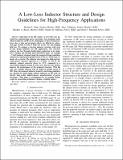A Low-Loss Inductor Structure and Design Guidelines for High-Frequency Applications
Author(s)
Yang, Rachel S.(Rachel Shanting); Hanson, Alex Jordan; Reese, Bradley A.; Sullivan, Charles R.; Perreault, David J.
DownloadTPEL_magnetic_structure_2018_final.pdf (364.2Kb)
Open Access Policy
Open Access Policy
Creative Commons Attribution-Noncommercial-Share Alike
Terms of use
Metadata
Show full item recordAbstract
Operation in the high-frequency (HF) regime (3-30 MHz) has potential for miniaturizing power electronics, but designing small efficient inductors at HF can be challenging. At these frequencies, losses due to skin and proximity effects are difficult to reduce, and gaps needed to keep B fields low in the core add fringing field loss. We propose a low-loss inductor structure with step-by-step design guidelines for HF applications. The structure achieves low loss through double-sided conduction in its single-layer winding and through quasi-distributed gaps. An example ~15 μH inductor designed using the proposed design guidelines achieved an experimental quality factor of 720 at 3 MHz and 2A (peak) of ac current. The inductor also improved a high-current-swing power converter operated at 1-3 MHz; at 250 W, the inductor reduced converter losses by 19%, compared to a conventional inductor design. In some cases, litz wire may further improve the performance of the proposed structure. With litz wire, the example inductor had an improved quality factor of 980. Thus, the proposed inductor geometry and design guidelines are suitable for small highly efficient inductors at HF and can thereby help realize high-frequency miniaturization of power electronics. (This paper is accompanied by an example Python script for generating preliminary designs, available in the online supplementary material).
Date issued
2019-10Department
Massachusetts Institute of Technology. Department of Electrical Engineering and Computer Science; Massachusetts Institute of Technology. Research Laboratory of ElectronicsJournal
IEEE Transactions on Power Electronics
Publisher
Institute of Electrical and Electronics Engineers (IEEE)
Citation
Yang, Rachel S. et al. "A Low-Loss Inductor Structure and Design Guidelines for High-Frequency Applications." IEEE Transactions on Power Electronics 34, 10 (October 2019): 9993 - 10005 © 2019 IEEE
Version: Author's final manuscript
ISSN
0885-8993
1941-0107